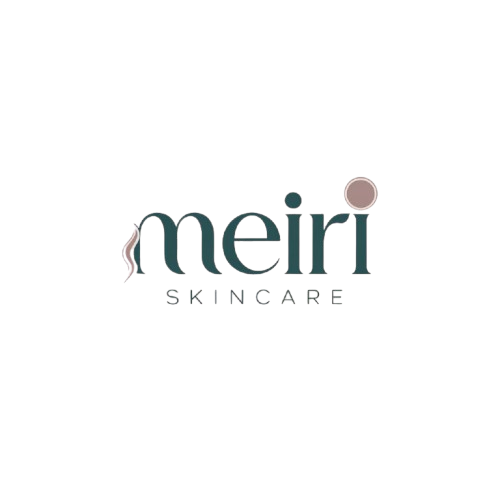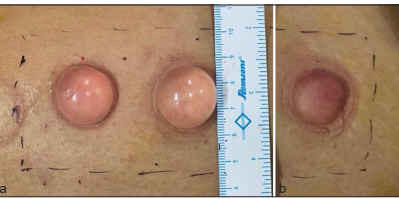
*Corresponding author: Akshay Arun Vetal, Department of Dermatology, Lokmanya Tilak Municipal Medical College and General Hospital, Mumbai, Maharashtra, India
Received: 23 July 2024
Accepted: 17 September 2024
Epub Ahead of Print: 22 November 2024
Published:
DOI
10.25259/CSDM_124_2024
Video available on:
https://doi.org/10.25259/
CSDM_124_2024
PROBLEM
Suction blister-based epidermal grafting involves the induction of subepidermal suction blisters
in the donor area by prolonged application of vacuum, with the subsequent transplantation of
its roof to the receptor area for transplanting viable epidermis. e method is advantageous in
melanocyte-bearing epidermis transplantation, ensuring both donor and recipient sites heal
without scarring. However, the major disadvantages are the time required for blister formation
and the limited yield of the graft.
e standard syringe design, often featuring relatively sharp-edged barrel flanges, can cause
discomfort and limit skin suction effectiveness. is surgical pearl introduces a modification
involving the use of a softened-edge syringe along with a shortened height, which expedites
blister formation, increases graft yield, and reduces the risk of hemorrhagic complications.
SOLUTION
The standardized suction blister device was set up as per Gupta et al., containing a 5/10/20 mL
disposable syringe connected to a 3-way tap with a latex rubber tube, a 50 mL syringe for air
aspiration, and a manometer for measuring negative pressure [Figure 1].[1] e 20-mL syringe was
halved using a precise cutting method [Figure 1]. e edges of the halved syringe were softened
using sandpaper and a gentle touch of a spirit lamp to further refine and roll the edges [Video 1].
is refined syringe was then integrated into the standard suction blister procedure [Figure 2].
is led to the formation of an intact blister with clear fluid, indicating successful epidermal
detachment from the dermoepidermal junction. Reducing the syringe volume by lowering its
height while maintaining constant suction pressure was expected to heighten pressure within
the syringe in accordance with Boyle’s law (P1V1 = P2V2).[2,3] is adjustment aims to expedite
the equilibration between the syringe and the patient’s skin, potentially accelerating blister
formation [Figure 3]. e softened edges reduced procedural pain and increased the effective
skin suction area by approximately 44%, thereby significantly increasing graft yield [Figure 4]. In
contrast to innovations introducing extra equipment, our distinct approach modified the original
This is an open-access article distributed under the terms of the Creative Commons Attribution-Non Commercial-Share Alike 4.0 License, which allows others
to remix, transform, and build upon the work non-commercially, as long as the author is credited and the new creations are licensed under the identical terms.
©2024 Published by Scientific Scholar on behalf of CosmoDerma
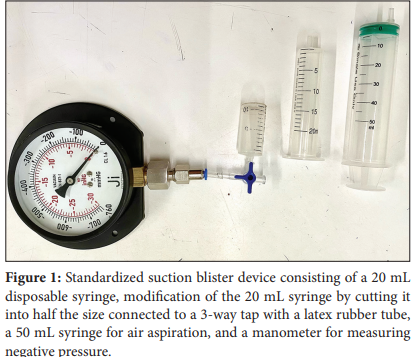
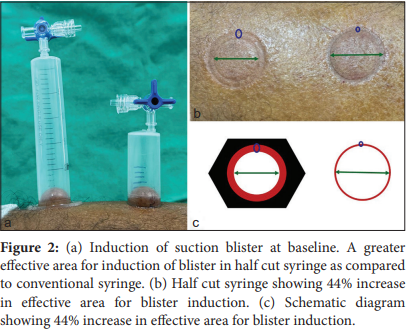
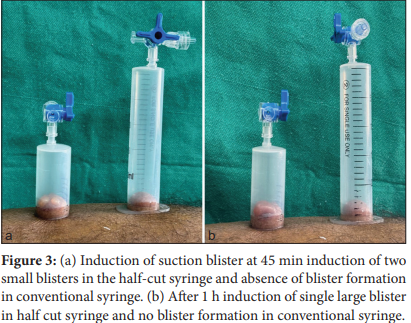
How to cite this article: Dhurat RS, Vetal AA, Chamle SM, Ranka A. Precision and efficiency unveiled: Optimizing suction blister formation through syringe edge refinement and height reduction. CosmoDerma. 2024;4:115. doi: 10.25259/CSDM_124_2024

procedure, marrying simplicity with efficacy through syringe
cut edge refinement with height reduction, which increased
the graft yield and reduced the time taken for the procedure
and complications associated with the procedure. Beyond
procedural efficiency, these changes prioritized patient
comfort. e potential impact of these modifications called
for further empirical validation, presenting promising
avenues for advancing suction blister procedures.
Ethical approval
The Institutional Review Board approval is not required.
Declaration of patient consent
The authors certify that they have obtained all appropriate
patient consent.
Financial support and sponsorship
Nil.
Conflicts of interest
There are no conflicts of interest.
Use of artificial intelligence (AI)-assisted technology for manuscript preparation
The authors confirm that there was no use of artificial
intelligence (AI)-assisted technology for assisting in the
writing or editing of the manuscript and no images were
manipulated using AI.
REFERENCES
- Gupta S, Ajith C, Kanwar AJ, Kumar B. Surgical pearl:
Standardized suction syringe for epidermal grafting. J Am
Acad Dermatol 2005;52:348-50. - Mukhtar M, Singh S, Shukla VK, Pandey SS. Surgical pearl:
Suction syringe for epidermal grafting. J Am Acad Dermatol
1997;37:638-9. - Lewis EJ, Kageyama N. e mechanism of “suction”. J Am Acad
Dermatol 1998;39(4 Pt 1):664.

